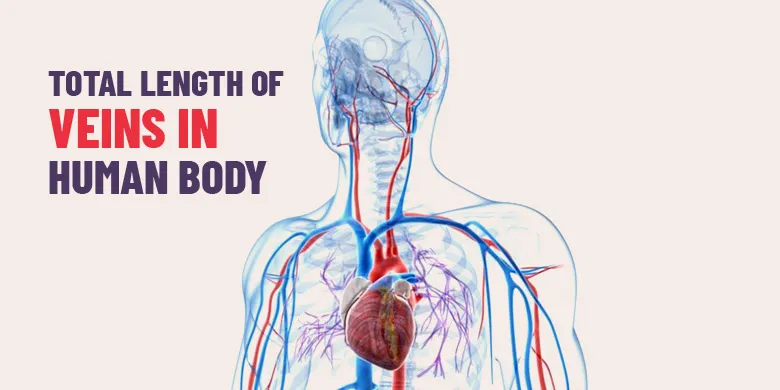Total Length of Veins in Human Body

Total Length of Veins in the Human Body The Visual Guide to Understanding the Human Body reveals that if all the blood vessels are taken out of the body and joined end to end in a single line, the total length will be about 150,000 kilometers! This is the combined length of the arteries, veins and other tubes carrying blood. If this rope of blood vessels is wrapped around the earth, it will circle the earth over three times!
This article primarily focusses on the total length of veins in the human body. The two major types of blood vessels – the arteries and the veins – especially differ from each other based on their anatomy and kind of blood they transport, i.e. their role in the cardiovascular system. Other differences lie in their structure and the location in the body.
Before proceeding to the total length of veins in the human body, let’s learn about the nature and function of the veins in contrast with that of the arteries.
The Veins vs The Arteries:
While the job of an artery is to receive the oxygenated blood from the heart and deliver it to each cell of the body, a vein does the reverse of it, i.e. it collects the blood from individual cells and carries it back to the heart for oxygenation in the lungs. The diameter of an artery goes on decreasing as it moves away from the heart, finally reducing to as low as 1mm or even less! So, depending on their size, different vessels have been assigned different names.
On the other hand, a vein goes on increasing in diameter as it gets closer to the heart. All the veins contain deoxygenated blood with the exception of the pulmonary and the umbilical veins, both of which transport oxygen-rich blood to the heart. The veins usually lie closer to the skin, are less muscular than the arteries, and mostly have valves to prevent the backflow of blood.
Total Length of Veins in Human Body:
Irving P. Herman, in the second edition of the book “Physics of the Human Body” talks about the length of as many as eleven types of blood vessels. These eleven types of vessels include arteries and veins and divisions of both. Here’re the lengths of different types of blood vessels in centimeters as given in Physics of the Human Body:
- Vena Cava – 40 cm
- Large Veins – 20 cm
- Main Venous Branches – 10 cm
- Terminal Venules – 1 cm
- Venules – 0.2 cm
- Capillaries – 0.1 cm
- Arterioles – 0.2 cm
- Terminal Artery Branches – 1 cm
- Main Artery Branches – 10 cm
- Large Arteries – 20 cm
- Aorta – 40 cm
Did you know about 80% of the total length of all blood vessels is contributed by the smallest of them, i.e. the capillaries?


